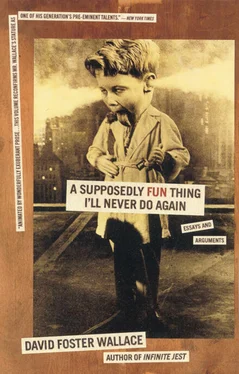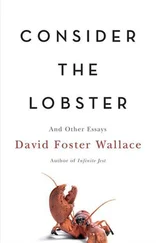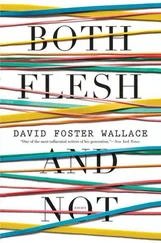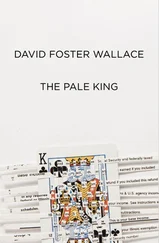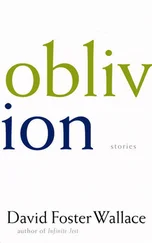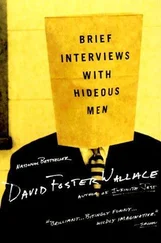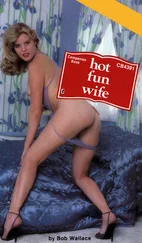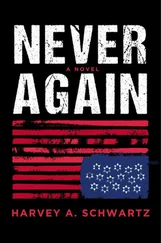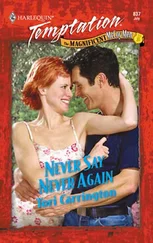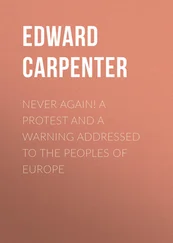The people I know from outside it distill the Midwest into blank flatness, black land and fields of green fronds or five-o’clock stubble, gentle swells and declivities that make the topology a sadistic exercise in plotting quadrics, highway vistas so same and dead they drive motorists mad. Those from IN/WI/Northern IL think of their own Midwest as agronomics and commodity futures and corn-detasseling and bean-walking and seed-company caps, apple-cheeked Nordic types, cider and slaughter and football games with white fogbanks of breath exiting helmets. But in the odd central pocket that is Champaign-Urbana, Rantoul, Philo, Mahomet-Seymour, Mattoon, Farmer City, and Tolono, Midwestern life is informed and deformed by wind. Weather-wise, our township is on the eastern upcurrent of what I once heard an atmospherist in brown tweed call a Thermal Anomaly. Something about southward rotations of crisp air off the Great Lakes and muggy southern stuff from Arkansas and Kentucky miscegenating, plus an odd dose of weird zephyrs from the Mississippi valley three hours west. Chicago calls itself the Windy City, but Chicago, one big windbreak, does not know from a true religious-type wind. And meteorologists have nothing to tell people in Philo, who know perfectly well that the real story is that to the west, between us and the Rockies, there is basically nothing tall, and that weird zephyrs and stirs joined breezes and gusts and thermals and downdrafts and whatever out over Nebraska and Kansas and moved east like streams into rivers and jets and military fronts that gathered like avalanches and roared in reverse down pioneer oxtrails, toward our own personal unsheltered asses. The worst was spring, boys’ high school tennis season, when the nets would stand out stiff as proud flags and an errant ball would blow clear to the easternmost fence, interrupting play on the next several courts. During a bad blow some of us would get rope out and tell Rob Lord, who was our fifth man in singles and spectrally thin, that we were going to have to tie him down to keep him from becoming a projectile. Autumn, usually about half as bad as spring, was a low constant roar and the massive clicking sound of continents of dry leaves being arranged into force-curves — I’d heard no sound remotely like this megaclicking until I heard, at nineteen, on New Brunswick’s Bay of Fundy, my first high-tide wave break and get sucked back out over a shore of polished pebbles. Summers were manic and gusty, then often around August deadly calm. The wind would just die some August days, and it was no relief at all; the cessation drove us nuts. Each August, we realized afresh how much the sound of wind had become part of the soundtrack to life in Philo. The sound of wind had become, for me, silence. When it went away, I was left with the squeak of the blood in my head and the aural glitter of all those little eardrum hairs quivering like a drunk in withdrawal. It was months after I moved to western MA before I could really sleep in the pussified whisper of New England’s wind-sound.
To your average outsider, Central Illinois looks ideal for sports. The ground, seen from the air, strongly suggests a board game: anally precise squares of dun or khaki cropland all cut and divided by plumb-straight tar roads (in all farmland, roads still seem more like impediments than avenues). In winter, the terrain always looks like Mannington bathroom tile, white quadrangles where bare (snow), black where trees and scrub have shaken free in the wind. From planes, it always looks to me like Monopoly or Life, or a lab maze for rats; then, from ground level, the arrayed fields of feed corn or soybeans, fields furrowed into lines as straight as only an Allis Chalmers and sextant can cut them, look laned like sprint tracks or Olympic pools, hashmarked for serious ball, replete with the angles and alleys of serious tennis. My part of the Midwest always looks laid down special, as if planned.
The terrain’s strengths are also its weaknesses. Because the land seems so even, designers of clubs and parks rarely bother to roll it flat before laying the asphalt for tennis courts. The result is usually a slight list that only a player who spends a lot of time on the courts will notice. Because tennis courts are for sun- and eye-reasons always laid lengthwise north-south, and because the land in Central Illinois rises very gently as one moves east toward Indiana and the subtle geologic summit that sends rivers doubled back against their own feeders somewhere in the east of that state, the court’s forehand half, for a rightie facing north, always seems physically uphill from the backhand — at a tournament in Richmond IN, just over the Ohio line, I noticed the tilt was reversed. The same soil that’s so full of humus farmers have to be bought off to keep markets unflooded keeps clay courts chocked with jimson and thistle and volunteer corn, and it splits asphalt courts open with the upward pressure of broadleaf weeds whose pioneer-stock seeds are unthwarted by a half-inch cover of sealant and stone. So that all but the very best maintained courts in the most affluent Illinois districts are their own little rural landscapes, with tufts and cracks and underground-seepage puddles being part of the lay that one plays. A court’s cracks always seem to start off to the side of the service box and meander in and back toward the service line. Foliated in pockets, the black cracks, especially against the forest green that contrasts with the barn red of the space outside the lines to signify fair territory, give the courts the eerie look of well-rivered sections of Illinois, seen from back aloft.
A tennis court, 78' × 27', looks, from above, with its slender rectangles of doubles alleys flanking its whole length, like a cardboard carton with flaps folded back. The net, 3.5 feet high at the posts, divides the court widthwise in half; the service lines divide each half again into backcourt and fore-. In the two forecourts, lines that run from the base of the net’s center to the service lines divide them into 21' × 13.5' service boxes. The sharply precise divisions and boundaries, together with the fact that — wind and your more exotic-type spins aside — balls can be made to travel in straight lines only, make textbook tennis plane geometry. It is billiards with balls that won’t hold still. It is chess on the run. It is to artillery and airstrikes what football is to infantry and attrition.
Tennis-wise, I had two preternatural gifts to compensate for not much physical talent. Make that three. The first was that I always sweated so much that I stayed fairly ventilated in all weathers. Oversweating seems an ambivalent blessing, and it didn’t exactly do wonders for my social life in high school, but it meant I could play for hours on a Turkish-bath July day and not flag a bit so long as I drank water and ate salty stuff between matches. I always looked like a drowned man by about game four, but I didn’t cramp, vomit, or pass out, unlike the gleaming Peoria kids whose hair never even lost its part right up until their eyes rolled up in their heads and they pitched forward onto the shimmering concrete. A bigger asset still was that I was extremely comfortable inside straight lines. None of the odd geometric claustrophobia that turns some gifted juniors into skittish zoo animals after a while. I found I felt best physically enwebbed in sharp angles, acute bisections, shaved corners. This was environmental. Philo, Illinois, is a cockeyed grid: nine north-south streets against six northeast-southwest, fifty-one gorgeous slanted-cruciform corners (the east and west intersection-angles’ tangents could be evaluated integrally in terms of their secants!) around a three-intersection central town common with a tank whose nozzle pointed northwest at Urbana, plus a frozen native son, felled on the Salerno beachhead, whose bronze hand pointed true north. In the late morning, the Salerno guy’s statue had a squat black shadow-arm against grass dense enough to putt on; in the evening the sun galvanized his left profile and cast his arm’s accusing shadow out to the right, bent at the angle of a stick in a pond. At college it suddenly occurred to me during a quiz that the differential between the direction the statue’s hand pointed and the arc of its shadow’s rotation was first-order. Anyway, most of my memories of childhood — whether of furrowed acreage, or of a harvester’s sentry duty along RR104W, or of the play of sharp shadows against the Legion Hall softball field’s dusk — I could now reconstruct on demand with an edge and protractor.
Читать дальше
